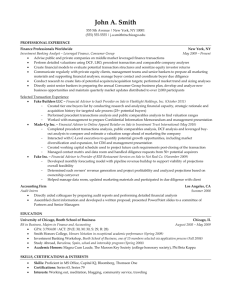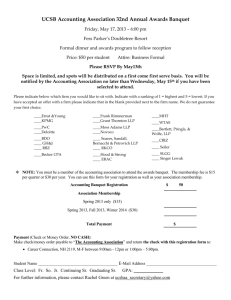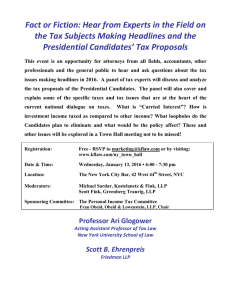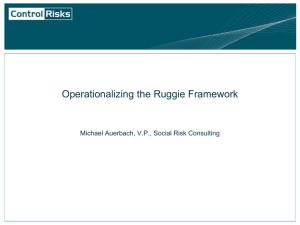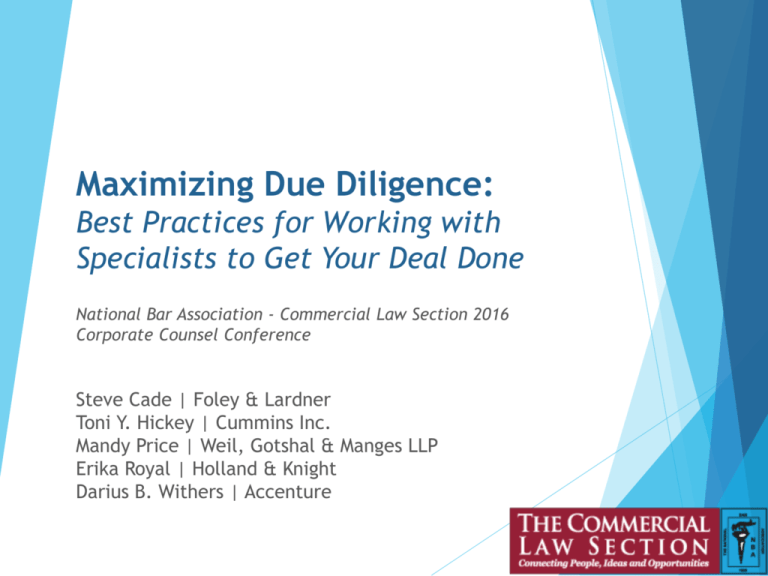
Maximizing Due Diligence:
Best Practices for Working with
Specialists to Get Your Deal Done
National Bar Association - Commercial Law Section 2016
Corporate Counsel Conference
Steve Cade | Foley & Lardner
Toni Y. Hickey | Cummins Inc.
Mandy Price | Weil, Gotshal & Manges LLP
Erika Royal | Holland & Knight
Darius B. Withers | Accenture
Legal Due Diligence Overview
Mandy Price
February 20, 2016
Weil, Gotshal & Manges LLP
Weil, Gotshal & Manges LLP
3
What Is “Due Diligence”?
■
Putting together the pieces . . . a review of the business,
legal and financial affairs of a company
■
Process involves lawyers, clients, accountants and, in some cases,
specialty service providers
Weil, Gotshal & Manges LLP
4
When Do We Perform Due Diligence?
Typical Timeline of a Private Equity/ M&A Transaction:
Proprietary
Sign Letter of Intent
Confidentiality
Agreement
Due
Diligence
Negotiate and
sign Purchase
Agreement;
Debt
Commitment
Letters
Pre-Closing
Matters
Negotiate
Financing
Documents
(e.g., Credit
Agreement)
Post Closing
Adjustments
Closing
Indemnity
Survival Period
Auction
Submit Bid Package
Weil, Gotshal & Manges LLP
5
Due Diligence Goals
■
■
■
■
■
Evaluate the target and understand its business
Confirm buyer will get what it thinks is being offered for sale
(i.e., an operating business, a specific set of assets, etc.)
Identify any issues, risks and obstacles as soon as possible
(e.g., consents; potential liabilities; irregularities) and
potential solutions
Sell-Side (“Reverse Diligence”) in connection with
preparation of Disclosure Schedules and anticipating deal
issues (e.g., consents)
Inform drafting of transaction documents and structure
Weil, Gotshal & Manges LLP
6
Why Perform Due Diligence?
■
■
Understand the value of the target and unearth any potential
liabilities
Inform negotiations and develop strategies
■
■
■
Structure the transaction and negotiate the transaction
agreement to address or avoid inherent risks of the target and
the deal
Gain leverage / mitigate imbalance of access to information
Has implications for the transaction agreements
■
■
e.g., representations and warranties, closing conditions
Documents reviewed will be reflected in disclosure schedules
to the transaction agreement
Weil, Gotshal & Manges LLP
7
Preparation and Preliminary Steps
■
Learn about the Target
■
■
■
■
Review target’s website; learn about the industry
Review publicly available information (e.g., filings
with SEC/other governmental agencies, press
releases, articles and industry reports)
Annual reports (CEO’s letter to shareholders)
Read information memorandum; financials (footnotes
are especially helpful)
Weil, Gotshal & Manges LLP
8
Preparation and Preliminary Steps (cont’d)
■
Establish a Timetable
■ Coordinate with your advisors so there is no
duplication of efforts and you save costs
■ Prioritize Review
■ Understand which, if any, materials are not to be
(fully) reviewed
■
■
Agreements being terminated or amended in connection with
the transaction
Historical agreements no longer effective/relevant (in whole
and in part)
Weil, Gotshal & Manges LLP
9
Issue Spotting – Limitations on Ability to
Complete the Transaction
■
■
■
Non-compete provisions (e.g., binding your affiliates)
Valuation issues
Are any consents / approvals necessary?
■
■
■
■
Third parties
Governmental entities
Is the transaction permitted under the target’s governing
documents?
What corporate actions are required for the transaction to
occur?
■
■
Is stockholder consent required? If so, what is the required
vote?
Has sufficient board approval been obtained?
Weil, Gotshal & Manges LLP
10
Issue Spotting – Limitations on the Value of the
Target (cont’d)
■
Will the transaction trigger any liabilities?
■
■
■
■
■
■
Payments to executives?
Change of control payments?
Repayment fees?
Acceleration of debt?
Consent fees?
Will the transaction trigger a default or termination
right of a third party?
■
Do contracts contain unusual termination provisions?
Weil, Gotshal & Manges LLP
11
Issue Spotting – Limitations on the Value of the
Target (cont’d)
■
Does the target have liabilities or commitments that the
buyer is not aware of?
■
■
■
■
■
■
■
■
■
Litigation?
Product liability/warranty claims?
Potential indemnification claims?
Capital expenditures?
Employment claims?
Underfunded benefit plans?
Violations of laws/permits?
Affiliate arrangements?
Cost escalation provisions?
Weil, Gotshal & Manges LLP
12
Typical Documents & Agreements
■
These are some of the typical documents you will find in a Dataroom:
■
■
■
■
■
■
■
■
■
■
■
■
■
Governing Documents (Certificate of Incorporation, Bylaws)
Partnership/Operating Agreements and Stockholder/Registration Rights
Agreements
Material Contracts (i.e. with customers, vendors)
Real Estate Leases (Real Property) and Capital Leases (Equipment)
Debt Documents
Acquisition Agreements (prior transactions)
Employment Agreements (including Consulting Contracts)
Litigation Related Materials
Intellectual Property Related Agreements (Licenses, IP Acquisitions)
Tax Filings and Other Tax Related Documentation
Insurance Policies
Regulatory Filings
Company Policies, Procedures & Handbooks (HR related, FCPA and
Environmental)
Weil, Gotshal & Manges LLP
13
Performing Due Diligence
Bringing in Specialists (cont’d)
■
■
■
Organize review by and follow up with specialists (both
internal and external)
Review of diligence by specialists is critical.
As lead attorney, M&A attorneys must
■
Keep the entire deal team informed of deal timeline, updates to
deal dynamics/timing/changes to scope
■
Ensure completion of due diligence review by all specialists
Weil, Gotshal & Manges LLP
14
Questions?
Weil, Gotshal & Manges LLP
15
The Due Diligence Process:
Working With Specialists
National Bar Association - Commercial Law Section 2016
Corporate Counsel Conference
Steve Cade
©2012 Foley & Lardner LLP
Form the team
Due diligence is interdisciplinary
Generally, a business lawyer coordinates
the process
©2012 Foley & Lardner LLP
Obtain input from specialist attorneys
in areas such as:
–
–
–
–
–
–
–
–
Tax
Environmental law
Real estate
Labor & employment
Employee benefits
Intellectual property
Finance
Government contracts
©2012 Foley & Lardner LLP
Why are specialists needed?
They help Identify impediments to, and
hidden costs of, a proposed transaction
– Key intellectual property owned by a third
party or the principal shareholder?
– Real estate owned by seller?
– Potential environmental liability?
– Required consent from a key lender?
©2012 Foley & Lardner LLP
Explain/understand the transaction
Diagram it
Ask questions
Make sure the assigning attorney explains
the deal
©2012 Foley & Lardner LLP
Explain/understand the transaction
Who’s the buyer?
Who’s the seller?
Who’s the lender?
Who’s the borrower?
Who’s the client?
Are there related parties?
Stock deal?
Asset deal?
©2012 Foley & Lardner LLP
Explain/understand the transaction
What are material contracts?
Will we have to do a legal opinion?
Why are the parties doing this
transaction?
Which party needs/wants it more?
©2012 Foley & Lardner LLP
Don’t get distracted
©2012 Foley & Lardner LLP
Due Diligence Checklists
Input from specialists is critical
Begin with a comprehensive due diligence
checklist
– a list of required documents and information
– submitted to the target company or borrower to guide
it in gathering materials
Several rounds of information requests
– Subsequent requests decline in size and focus on
identified potential problem areas or holes in what
has been provided
©2012 Foley & Lardner LLP
Start early and be aware of deadlines
– How long will it take for surveys to be
prepared?
– For title insurance?
– For Phase I Environmental Site
Assessments?
Be proactive
©2012 Foley & Lardner LLP
Due diligence memo
Ask what you should produce
– A memo of varying length
– Summarizing the information reviewed
– Summarizing risks and issues identified
– Chart summarizing key provisions in material
leases, permits, licenses, employment
agreements, etc.
©2012 Foley & Lardner LLP
Due diligence memo
In securities offerings as issuer’s counsel,
typically very cursory
– Just note what was reviewed
– Discard notes
– Rely upon offering document
The theory: if it’s material, it’s in the offering document
Counsel for the underwriters will conduct a more
thorough review
– Underwriters conduct an extensive review of an
issuers business, legal and financial affairs,
especially for an initial public offering
©2012 Foley & Lardner LLP
How Much Due Diligence Do
You Do?
©2012 Foley & Lardner LLP
Depends upon the transaction and the
target
No bright-line tests
Be dogged
Use common sense
©2012 Foley & Lardner LLP
In loan transactions, lender’s and
borrower’s counsel conduct fairly limited
due diligence reviews
Too much can endanger or delay a
transaction or harm relationships
Too little can leave the parties open to
unknown risks
©2012 Foley & Lardner LLP
Questions?
©2012 Foley & Lardner LLP
Due Diligence Issues in Deals:
Government Contracting
- A Brief Overview: Darius B. Withers
National Bar Association Commercial Law Section
February 20, 2016
Notice and Disclaimer
The opinions expressed herein are the views of the author alone, may not reflect or
represent the views or positions Accenture, LLP, Accenture plc and/or any of its worldwide
affiliates, and should not be attributed to any other individual or entity nor should they
constitute legal opinion or advice.
To the degree they are included, “Accenture”, the Accenture logo, and High Performance
Delivered are trademarks of Accenture and/or its affiliates in the United States and other
countries. This document may make reference to trademarks that may be owned by
others. The use of such trademarks herein is not an assertion of ownership of such
trademarks by Accenture.
Copyright © 2012 Accenture All rights reserved.
33
Broad Overview of Government Contracting and
Due Diligence Issues
•
Government Contracting reflects a different contracting theory than
traditional contracting, based in part on the concepts arising out of
sovereign immunity and the powers of a government to enter into
agreements.
•
Government Contracting is a significant element of the US Economy. The
Federal Government alone spent 500 Billion in Contracting dollars in
2012.1; State Governments spent in excess of $2 Trillion in 20122.
•
As such, the concepts of due diligence in Government Contracting can
be different and unique from the Commercial sector.
•
The scenarios where careful due diligence arise include contracting
directly with the government, subcontracting with another company to
serve a government entity, and the various corporate activities
associated with participating in government contracting (including
acquisitions, IP licensing, or regulatory qualifications)
-
*1: Federal Contracts and the Contracted Workforce”, US Congressional Budget Office, March 2015 Report (March 11, 2015); *2: “State & Local
Government Procurement”, Conway, American Bar Association (2012)
Copyright © 2012 Accenture All rights reserved.
34
Key Laws and Regulations applicable to
Government Contracting
•
The Federal Acquisition Regulation (FAR) is the principal set of
regulations governing virtually all US Federal procurements.
–
–
The FAR applies to all departments of the U.S. government, certain
independent organizations, and most wholly-owned government corporations.
It is lengthy and detailed. These departments and entities also have separate
supplements to the FAR that apply to their procurements.
Prime contractors are required to flow down many of the FAR requirements in
their contracts to their Subcontractors
•
The Competition in Contracting Act of 1984; The Federal Acquisition
Streamlining Act; The Federal Acquisition Reform Act; The Truth in
Negotiations Act of 1962
•
The False Claims Act; False Statement to Government Agency; Public
Contracts Anti-Kickback Act
•
The Privacy Act and various Freedom of Information Act provisions
•
NOTE: State & Local Governments may incorporate FAR provisions into
their Contracts and impose their own unique set of rules and policies
concerning Contracting
Copyright © 2012 Accenture All rights reserved.
35
Consulting with Subject Matter Experts (SMEs) in
Government Contracting
•
Although Government Contracting is unique, to conduct any due
diligence required to close your deal, you will still need to seek the
input and involvement of Subject Matter Experts (SMEs).
•
SMEs you may work with are not significantly different than a
traditional commercial/ private sector transaction. But, the focus and
understanding of key issues may be different.
•
Areas of SME focus you may need to complete due diligence
activities in government contracting include: Human Resources/
Labor and Employment Law | Regulated Offerings | Intellectual
Property and Software Licensing | Antitrust | Litigation | Government
Affairs – Lobbyists
–
–
If you are In-House, these resources may already reside within your
organization – depending on the size of your in-house organization.
By contrast, if you are an Outside Counsel, your Government Contracts
Client will surely require the benefit of your expertise in these areas.
Copyright © 2012 Accenture All rights reserved.
36
Government Contracting Due Diligence Scenarios
For your consideration:
Your
Company/ Client is a Prime Contractor seeking to team and
subcontract with an owner of specialized, but unproven, technology to
offer services to the Federal Government.
Your
Company/ Client is seeking to provide staff augmentation
services to a State Government; the most appropriate resources to
staff the job are located offshore/ overseas.
Your Company/ Client is focused primarily on the provision of
services and the sales of goods in a Private/ Commercial Context.
Your Client Sales Lead, however, discovers a new opportunity with a
State Government – but the provision of such services are in a highly
regulated industry that includes supportive funding from the Federal
Government.
Copyright © 2012 Accenture All rights reserved.
37
Maximizing Due Diligence:
EMPLOYMENT LAW
National Bar Association - Commercial Law Section 2016 Corporate Counsel Conference
Erika R. Royal, Esq.
February 20, 2016
.
Copyright © 2016 Holland & Knight LLP. All Rights Reserved
Labor and Employment – Due Diligence
•
Director and Officer organizational chart
•
List(s) of all employees by function/classification/salary
•
Employment and other contracts
•
Liability insurance policies for directors and officers
•
Employee handbooks and other personnel policies and work rules
•
Independent contractor/consultant agreements
•
Labor union contracts and collective bargaining agreements
•
Pending employment litigation, charges or complaints
•
Information regarding fulfillment of workers’ compensation and unemployment
compensation insurance obligations
•
Citations or violations from OSHA or any other, similar regulatory body.
•
Non-competition, confidentiality or other restrictive covenant or similar agreements
39
Employment Law Due Diligence
•
Buyer will need to identify key management and non-management personnel that will be
crucial to retain post-acquisition if the merger/transaction is going to be successful.
Buyer must consider whether to offer employment on the same or similar terms.
•
Also, identify any cultural problems between the two companies
(leadership/management styles, implicit norms and values, work ethic/expectations – ie.,
valuing teamwork v. putting a premium on individual performance).
40
General L&E Successor Liability
•
In a stock purchase, the buyer generally assumes all of the target business’s labor and
employment-related liabilities and obligations.
•
In an asset purchase, the buyer may become liable for many of the target business’s
labor and employment liabilities under the equitable theory of successor liability or
common law.
•
Successor Liability depends on the following:
– Whether the successor had notice of the claim;
– Whether there is a substantiality continuity of operations from the predecessor to
the successor;
– Whether the predecessor is incapable of providing substantially all of the
requested relief.
41
Unions
National Labor Relations Act:
•
There is a presumption that a merger or stock sale will result in an obligation to continue
existing union relationships and agreements (just like any other existing contractual
obligation).
•
Generally speaking, a buyer that purchases the assets of a company with a unionized
workforce will not be bound by the target business’s Collective Bargaining Agreements
and does not have to recognize or bargain with the union if it is not a successor under
the NLRA.
•
A buyer in an asset purchase will generally be deemed a successor employer under the
NLRA if it operates the assets of the predecessor in essentially the same way
(“continuity of operations”); AND,
•
A majority of its workforce consists of employees who worked for the predecessor.
42
Successor Liability, generally
Under the equitable doctrine of successor liability, a court may impose liability on the
successor employer for various employment-related causes of action, including:
•
Violations of Wage and Hour laws
•
Contractual obligations
•
Discrimination/harassment
43
Violation of Wage and Hour Laws
One of the most common sources of successor liability involves misclassification of
workers. Liability for misclassification of workers generally depends on the following:
•
Whether employees are property classified as exempt under the Fair Labor Standards
Act (for example, as executive, administrative, learned professionals or computer
professionals) and therefore are not eligible for overtime pay for work performed in
excess of 40 hours per work week.
•
Whether workers are properly classified as independent contractors, rather than
employees, and therefore are not subject to FICA tax withholdings, workers’
compensation coverage, state unemployment insurance payments, overtime and other
employment-related coverage like employee health benefits.
•
Most wage and hour cases are brought as collective or class actions and can involve
millions of dollars in potential damages to employers, including millions of dollars in
Plaintiffs’ attorney’s fees.
44
Remedies available for wage and hour violations
Potential exposure for misclassification of workers as independent contractors can include
liability for the following:
•
Back taxes to federal, state and local governments.
•
Overtime pay under federal and/or state law.
•
Retroactive application of various employee benefits,
such as pension, health benefits.
45
Successor Liability for Seller’s Contracts
•
•
Employment and/or severance agreements
•
May create rights and obligations for buyer
•
Seller typically enacts these agreements, with key employees, near time of
transaction to guarantee that it can retain those employees and deliver an intact
management team at closing.
•
Such agreements may have substantial severance obligations that can increase the
transaction cost and make it difficult to retain these same employees following
closing.
Non-Competition provisions/agreements
•
State law determines whether non-competition or other restrictive covenants are
assignable by operation of law, whether they must contain express language
permitting assignment and whether Buyer must obtain employees express
agreement.
46
Successor Liability for Seller’s Discrimination
Buyer may be held liable for Seller’s violation of employment discrimination/harassment
and anti-retaliation laws or for remedying Seller’s violations of those laws if the Buyer is the
successor to the Seller’s operations.
A similar multi-factor “successorship” test is applied to determine liability.
47
Successor Liability for Employment Related Claims
Factors:
•
Did the Buyer have notice of the claim/charge/complaint?
•
Effective due diligence will usually mean that the Buyer was aware of any pending
claims.
•
Is Seller able to provide relief?
•
Is there substantial continuity of business operations with Buyer?
– Does Buyer employ substantially the same work force post-transaction?
– Does Buyer employ substantially the same supervisory personnel?
– Do the same jobs exist under essentially the same working conditions?
48
Worker Adjustment and Retraining Notification Act
The Worker Adjustment and Retraining Notification Act ("WARN Act") requires employers
to provide notice 60 days in advance of covered plant closings and covered mass layoffs.
This notice must be provided to either the affected workers or their representatives (e.g., a
labor union); to the State dislocated worker unit; and to the appropriate unit of local
government.
49
WARN Act Sales Exclusion Rules
•
Generally, termination of employees by Seller as part of closing a sale is not an
employment loss triggering WARN obligations, provided that the Buyer is purchasing
company as a “going concern” and hires or offers to hire Seller’s employees and fewer
than fifty employees are not hired by Buyer.
•
However, if Seller has previously closed the facility and laid off its employees and the
transaction is only for the sale of assets (ie., equipment, tools, facility), the transaction
will not fall within the sales exclusion and Seller will be responsible for providing all
required WARN notices.
•
Employees of Seller on the date of the sale are deemed employees of the Buyer after
the sale, even if there is a technical termination of employment as a consequence of the
sale. Buyer assumes all subsequent WARN notice obligations following closing of the
transaction.
•
Doctrine of successor liability is not a proper basis for imposing WARN Act obligations.
50
IP Due Diligence
February 20, 2016
Toni Y. Hickey
Deputy General Counsel & Chief IP Counsel
Cummins Inc.
Why Conduct IP Due Diligence?
IP Due Diligence is a systematic review of the IP developed, owned, acquired or used by a business
1. Merger or Acquisition
2. Potential Collaborative Relationship
- Joint Venture
- Joint Development
3. Licensing Opportunities
4. Litigation
5. Portfolio Valuation
- Sale, IPO, Divestiture
- Third Party Analysis / Investigation
- Bankruptcy, Reduction in Force, Elimination of significant lines of business
Why Conduct IP Due Diligence?
IP Due Diligence is a systematic review of the IP developed, owned, acquired or used by a business
1. Merger or Acquisition
2. Potential Collaborative Relationship
- Joint Venture
- Joint Development
3. Licensing Opportunities
4. Litigation
5. Portfolio Valuation
- Sale, IPO, Divestiture
- Third Party Analysis / Investigation
- Bankruptcy, Reduction in Force, Elimination of significant lines of business
Determine the goal(s) for the IP Due Diligence
What type of transaction?
1.
-
Asset Purchase
-
Stock Purchase
2.
What is the timeline?
3.
What do you want to know vs. need to know?
4.
What is needed from the transaction?
-
Ownership
-
Operational/Manufacturing
-
Competitive Use/Exclusivity
Identify the Intellectual Property
Use a detailed checklist that minimizes the chances of leaving out one or more relevant
steps from the process and is capable of being easily modified to take into consideration
the type of transaction.
•
Asset identification should include:
Patents, Trademarks, Copyrights, Domains,
Rights of Publicity
Fictional Names/DBAs
Trade Secrets/Know-How/Processes (“ShowHow”)/Confidential Information
Software/Databases/Source Code / Escrow / Open
Source
Each current and beneficial owners
License (In/Out) Agreements
Registered: Jurisdiction
IT Agreements
Application/Registration Numbers
Non-Compete/Confidentiality / Employment Agreements
Filing and Issue/Registration Dates
Any claim or dispute involving Company IP
Deadlines (renewals, maintenance etc.)
• For All Assets IP determine:
Unregistered: Intentional
55
Analyze the IP
•
Understand any ownership issues (sole, joint)
•
Understand the scope of protection (claims) of a patent and services covered by a trademark
•
Understand the terms of the rights (e.g. duration of protection and technological usefulness)
•
Understand if there are any product restrictions (e.g. regulatory etc.)
•
Understand if the software agreements ensure continued access to code
•
Consider local IP laws and associated requirements/ restrictions
•
Determine whether the IP assets of the company are tied to the financing of the deal
•
Assess the potential for a third party claim of infringement or damages
•
Understand the terms in executed/pre-existing IP agreements (exclusivity, royalties, assignability,
government/foundation/university entity as a party)
•
Understand terms of employee agreements
-
Assignment of IP interest to the Company & Continuing Obligation to Assist with Prosecution
-
Compensation for inventors (remuneration)
-
Wavier of moral rights in all copyright works
-
Restrictions on disclosure or use of confidential information & Non-compete
56
Analyze the IP
Example: Technology Based Deal
Scientific Information
– Provide a description of scientific basis for Company technology, including general
explanation of principles underlying each product.
– Provide copies of technical literature, journal articles or other publications or
presentations elucidating scientific basis for Company technology.
– Provide copies of presentations prepared for investors that include descriptions of
scientific basis for Company technology.
– Provide copies of presentations prepared for investors that include descriptions of
scientific basis for Company technology.
– Provide a list of Company employees and/or consultants most familiar with scientific
aspects of Company technology, with description of each individual’s role at the
Company and general area of technical expertise.
57
Mitigate Risks
Comprehensive Due Diligence will reveal issues:
•
Register unregistered rights or create internal inventory
•
Record unregistered licenses where required by local law
•
Ensure maintenance/annuity and associated costs are current/paid
•
Record assignments and full chain of title
•
Perform necessary searching/analysis to ensure FTO
•
Escrow to mitigate risk where needed for IP infringement defense/damages
•
Obtain consent from Licensor/Licensee for transfer and/or amendment of agreements
•
Understand where relevant IP policies, procedures and management practices need
improvement (e.g. acquisition, merger)
•
Determine if there have been changes in administrative, legal and regulatory procedures
necessary for maintaining IP assets
59


